USDOT Thriving Communities Program: Lansing, MI
15 minutes Date Launched/Enacted: May 19, 2025 Date Published: May 19, 2025
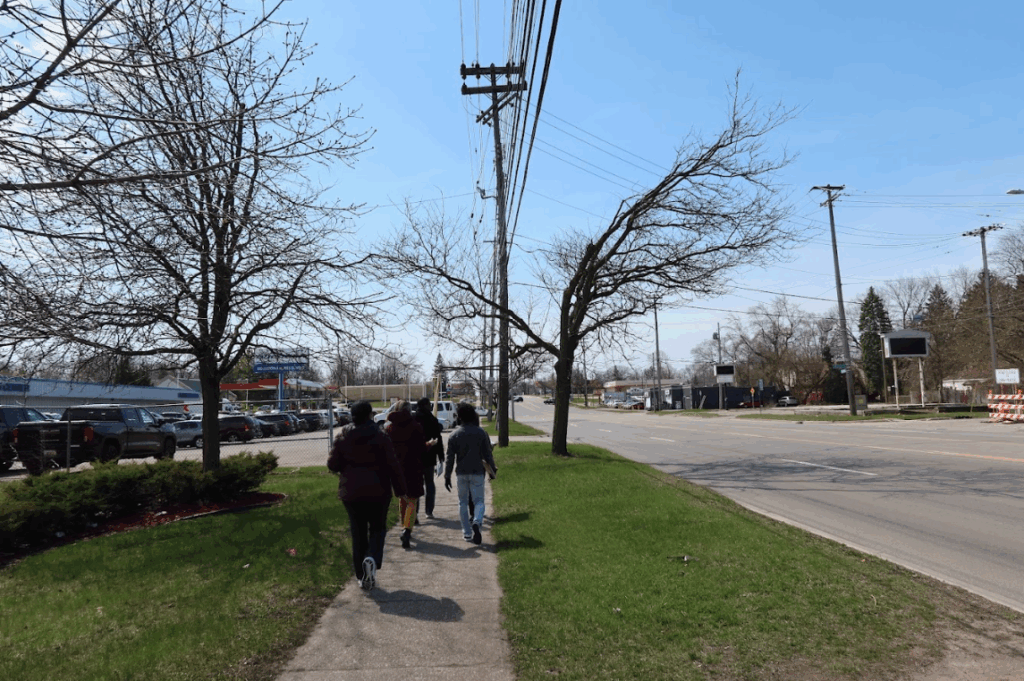
About the Thriving Communities Program (TCP)
The Thriving Communities Program (TCP) provides funding for tailored technical assistance to under-resourced and disadvantaged communities, helping them access historic infrastructure investments and deliver transformative projects. The USDOT FY 2022 Thriving Communities Program supports 64 communities nationwide by providing access to a team of capacity builders. These subject matter experts support communities in developing innovative community engagement methods, identifying funding opportunities, and strengthening their long-term capacity to develop and deliver transportation projects that enhance community wellbeing.
TCP Complete Neighborhoods Community of Practice
TCP Communities are grouped into three Communities of Practice: Main Streets, Networked Communities, and Complete Neighborhoods. The 15 communities included under the Complete Neighborhoods Community of Practice are:
| Atlantic Beach, SC | Isabela, PR | Santa Cruz, CA |
| Billings, MT | Lansing, MI | St. Louis County, MO |
| Decatur, IL | Lima, OH | Suffolk, NY |
| East Orange, NJ | Providence, RI | Sumter, SC |
| Indianapolis, IN | Roanoke, VA | Waukegan, IL |
The US Department of Transportation (USDOT) selected a capacity building team led by RMI, including: the American Council for Energy-Efficient Economy (ACEEE), Equitable Cities, Nelson\Nygaard, and the Shared-Use Mobility Center (SUMC), to provide technical assistance to these 15 communities.

A Snapshot of Lansing, Michigan
ACEEE is the lead of the Capacity Builder team for the City of Lansing, which applied to participate in the Thriving Communities Program to improve pedestrian safety and economic development in Southwest Lansing. In the 1960s, the construction of Interstate 496 (I-496) displaced hundreds of Black families who, due to redlining restrictions, ended up living in public housing in this part of the city. White flight and disinvestment in the area resulted in the economic deterioration of Southwest Lansing. Today, based on data from the Environmental Justice Screening and Mapping Tool (EJScreen), 46% of households in Southwest Lansing are classified as low-income, and most of the community lacks critical services such as access to grocery stores.
South Martin Luther King Jr. Boulevard (S MLK Jr. Blvd.) is a major roadway running through Southwest Lansing, serving as a connector between the neighborhood and downtown Lansing. With five lanes, a speed limit of 45 mph, and traffic signals spread far apart, S MLK Jr. Blvd. is a dangerous road for pedestrians to cross. Between 2014 and 2023, based on data analyzed by Capacity Builders, 29% of the fatal pedestrian crashes in Lansing occurred on S MLK Jr. Blvd. between Mt. Hope Ave and Miller Rd. Despite these challenges, Southwest Lansing is supported by a strong network of community organizations actively involved in strengthening their neighborhood.
Initiatives for Transportation
To address safety concerns and promote economic growth along the S. MLK Jr. Boulevard corridor, the City of Lansing established the S MLK Jr. Blvd. Corridor Improvement Authority in 2019. In 2022, the Authority published a Development and Tax Increment Financing Plan, which identified traffic calming measures as a desired strategy for the corridor. However, funding remains a barrier for the Michigan Department of Transportation (MDOT), which owns the road.
Additionally, the city and other local partners indicated a need for better coordination between various public sector stakeholders (e.g., MDOT, the Lansing Economic Development Corporation, the City itself, the transit agency, and the metropolitan planning organization, etc.). Coordinated planning is crucial for conducting public engagement for and executing transportation projects. Reaching more community members with public engagement was a priority for local partners. Finally, attracting more businesses to Southwest Lansing, especially healthcare services, banks, and grocery stores, was a primary goal for the city and other partners.
Key Partners
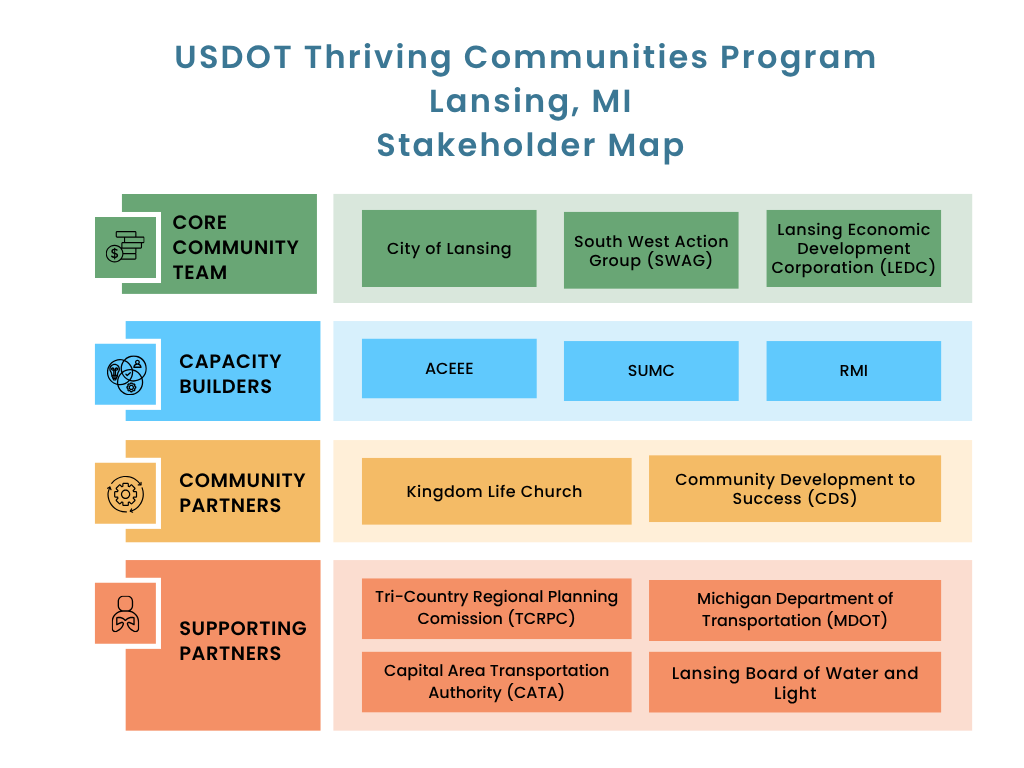
Stakeholder map. Credit: SUMC
Activities through the Thriving Communities Program
Identifying Safety Improvements for S MLK Jr. Blvd.
The City of Lansing was awarded a FY22 Safe Streets for All discretionary grant by USDOT to develop a safety action plan. The plan’s goal is to eliminate roadway deaths. It will use data and community input to identify where the most pressing traffic safety issues occur and develop strategies to mitigate them. After a round of edits based on community input, the plan is expected to be adopted by Lansing City Council in June 2025.
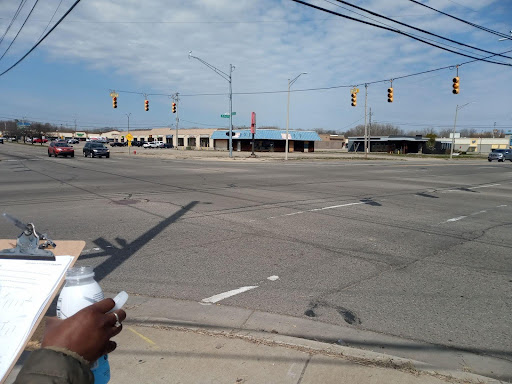
The intersection of S MLK Jr. Blvd. and Holmes Rd. This intersection was identified by capacity builders as one of three crash hotspots along S MLK Jr. Blvd. Credit: ACEEE
To support the development of projects for S MLK Jr. Blvd, the Capacity Building team analyzed crashes involving pedestrians and bicyclists on S MLK Jr. Blvd. from 2014 to 2023. In addition to finding that 29% of the city’s fatal pedestrian crashes occur on this corridor, the team found that over half of serious and fatal bike and pedestrian crashes occurred after dark. The Capacity Building team identified three crash hotspots and developed potential safety countermeasures for these hotspots, as well as countermeasures to apply along the corridor.
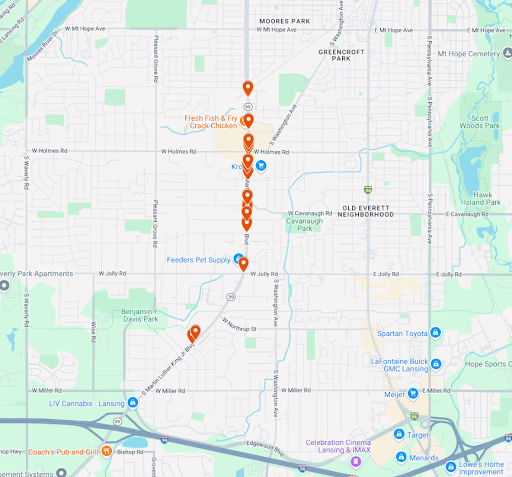
A map showing the 20 crashes involving a serious or fatal injury of a pedestrian or bicyclist along S MLK Jr. Blvd. between 2014 and 2023. Credit: ACEEE
The Capacity Building team brought findings and suggestions to the S MLK Corridor Improvement Authority’s board meeting to get input from the board, which is largely composed of small business owners along the road, and other attendees. The team also worked with the Michigan Department of Transportation (MDOT), the roadway owner, to better understand the different processes for implementing these countermeasures and discuss funding opportunities. The Capacity Building team collaborated with community-based organizations todraft public comments for the safety action plan that incorporated these suggested improvements. Looking forward, the City intends to apply for a future infrastructure grant to obtain funding to implement safety projects.
Improving coordination between public sector agencies and expanding public engagement
Two primary requests from the city and other key partners were support for improving coordination and communication in the project planning process and expansion of current community engagement processes to reach a wider audience. Across several meetings, the Capacity Building team learned about existing processes and the challenges, such as limited capacity, faced by many partners. One of these meetings took place in person, where the Capacity Building team convened staff from three city departments, MDOT, Tri-County Regional Planning Commission, and Lansing Economic Development Corporation to discuss the challenges facing S MLK Jr. Blvd. and upcoming plans and projects affecting the corridor. The team also met with several community-based organizations in Southwest Lansing to learn more about their challenges and how they would like to engage with public projects.
The Capacity Builder team ultimately developed a set of six recommendations to improve stakeholder coordination and community engagement. One recommendation was to host quarterly meetings with the relevant city departments and public sector agencies involved in transportation planning and project implementation. During these meetings, each stakeholder provides an update on a project or plan that is underway, or will soon be kicking off, and shares any requests for existing resources that others may have that could support this effort. The team recommended that the agency hosting these quarterly meetings rotate every four meetings, to avoid overburdening any particular agency.
Capacity builders supported local partners in implementing these recommendations by facilitating the first quarterly meeting in April 2025. The Capacity Building Team also presented these recommendations to the Mayor Andy Schor, who supported the recommendations relating to cross-departmental coordination and decided to institute his own collaborative process for community engagement that impacts all city public engagement initiatives, and not just transportation-related engagement.
Finally, direct funding available through TCP enabled capacity builders to contract with two community-based organizations in Southwest Lansing, South West Action Group and Community Development to Success, to host community events and support the city’s public engagement efforts by sharing surveys on current planning initiatives at these events.
Supporting small businesses and critical services in Southwest Lansing
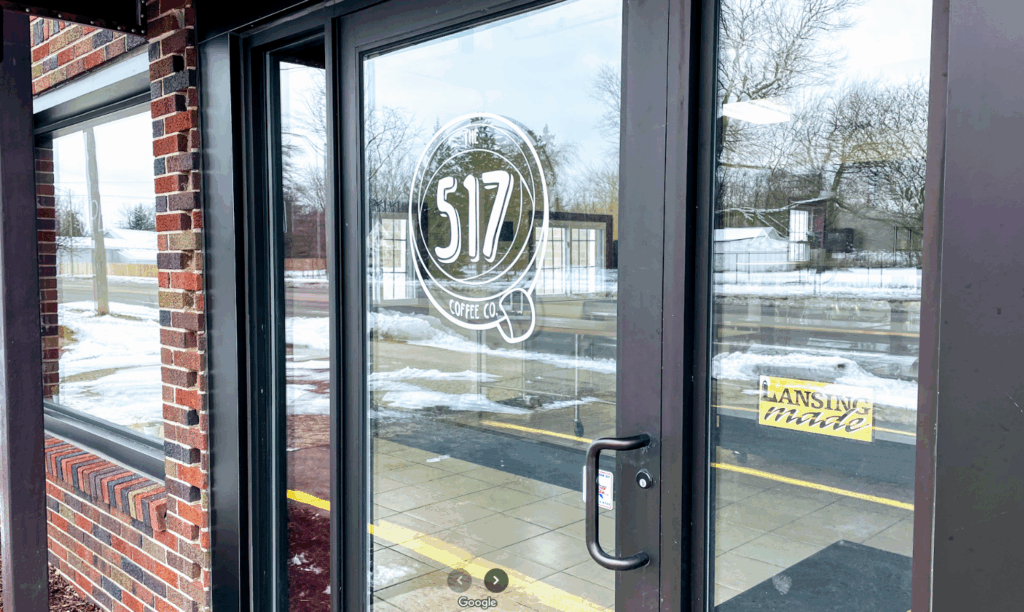
The entrance to 517 Coffee – one of the local businesses that will participate in the small business support program offered by Opsidia. Credit: ACEEE
The Southwest Lansing community has a strong entrepreneurial spirit. This is exemplified by the South Lansing Farmers Market, which brings dozens of small businesses together each summer and fall to promote their goods and services. Supporting these businesses was a major request from key partners.
With direct funding through TCP, the Capacity Building team worked with a small business consulting firm, Opsidia, to provide educational classes for Southwest Lansing entrepreneurs. These classes cover essential content, including streamlining operations, strengthening marketing, complying with legal requirements, and more. The program also offers one-on-one coaching for participants. Of the businesses that applied to participate, nine qualified based on geographic and other criteria and were accepted into the program. These businesses provide products and services ranging from coffee to networking events to event rentals. Participants will not only gain access to classes and coaching, but also to a network of Opsidia alumni, which will open the doors for future partnerships and mentorship.
Finally, the Capacity Builder team is working to support the ongoing Invest Health initiative by compiling case studies on other communities that have leveraged public-private partnerships and resources to expand healthcare access through strategies including attracting additional clinics and other medical offices to areas in need of healthcare services, expanding transport and mobile health clinic services, or improving communication and understanding of existing healthcare resources. With McLaren Health Care planning to open a facility in Southwest Lansing, the Capacity Building team conducted research to identify the gaps in access that would still exist, and offered key considerations for future efforts to expand access to healthcare in the area.
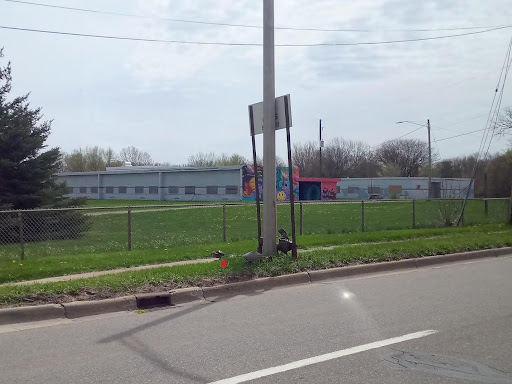
The former Maple Grove Elementary School, which sits on S MLK Jr. Blvd. Kingdom Life Church hopes to convert the abandoned building into a community center with spaces for much-needed services, such as dental clinics. Credit: ACEEE
Other Initiatives
Capacity builders were also able to contract with LEDC to host a local art contest focused on South Lansing and Dr. Martin Luther King Jr. Four submissions were selected and winning artists were awarded $500 per selected piece from the S MLK Corridor Improvement Authority. The winning submissions will be converted into a vinyl wrap and installed on bus shelters along S MLK Jr. Blvd. This supported ongoing efforts to beautify the corridor with public art by local residents.
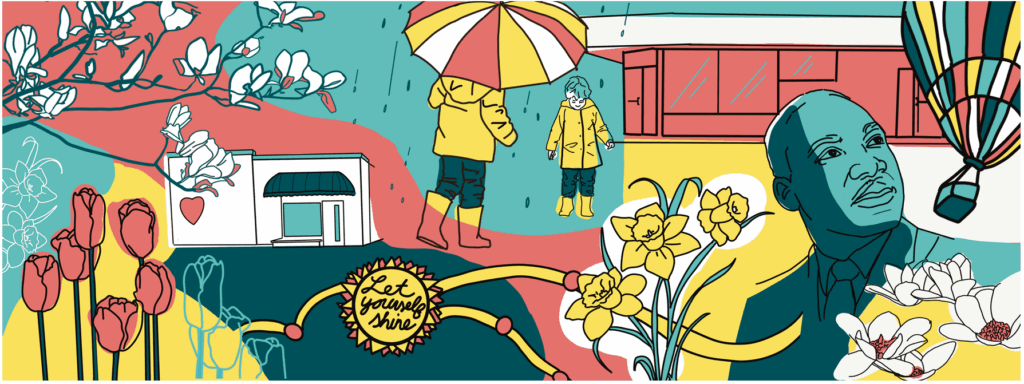
Artwork by M. Tawney Thaler that was selected through the S MLK Jr. Blvd. Bus Shelter Art Competition to be printed and installed on a bus shelter.
Related Resources
Capacity building efforts through the Thriving Communities Program will continue until May 2025. The Capacity Builder team will conduct more technical assistance activities and will update this case study as the program progresses.